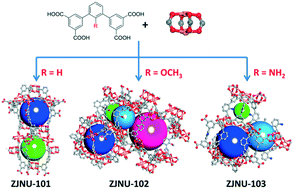Tailoring the structures and gas adsorption properties of copper–bent diisophthalate frameworks by a substituent-driven ligand conformation regulation strategy†
Abstract
Tailoring the structures and properties of metal–organic frameworks (MOFs) is very important for developing porous MOFs for targeted applications. Bent diisophthalate ligands offer a rich opportunity to construct MOFs with variable topologies because of their conformation flexibility and diversity. In this work, by employing a substituent-induced ligand conformation regulation strategy, we designed and synthesized three bent diisophthalate ligands bearing different substituents, and successfully constructed their corresponding dicopper paddlewheel-based MOFs under suitable solvothermal conditions. As revealed by single-crystal structural analyses, they feature distinct topological structures, depending on the attached substituents. Interestingly, the methoxy-functionalized MOF exhibits a novel topology, thus enriching the structural diversity of copper-bent diisophthalate frameworks. Furthermore, their gas adsorption properties with respect to C2H2, CO2, and CH4 were systematically investigated, revealing their promising potential for industrially important C2H2/CH4 and CO2/CH4 separations. More significantly, their separation performance can be greatly tailored by changing the substituents. Under ambient conditions, C2H2 and CO2 uptake capacities vary from 157.7 to 184.5 cm3 (STP) g−1, and 90.8 to 101.3 cm3 (STP) g−1, respectively, while C2H2/CH4 (50/50, v/v) and CO2/CH4 (50/50, v/v) adsorption selectivities range from 30.0 to 36.2, and 5.27 to 6.01, respectively. The amino-functionalized MOF performed better than the other two counterparts, which might be due to the synergistic effect arising from Lewis basic amino groups, higher density of open copper sites, and more suitable pore size. This work not only reported three MOFs for preferable adsorption of C2H2 and CO2 over CH4, but also demonstrated that the substituent-driven ligand conformation regulation is a facile way to modulate the structures and thus gas adsorption properties of MOFs.



 Please wait while we load your content...
Please wait while we load your content...